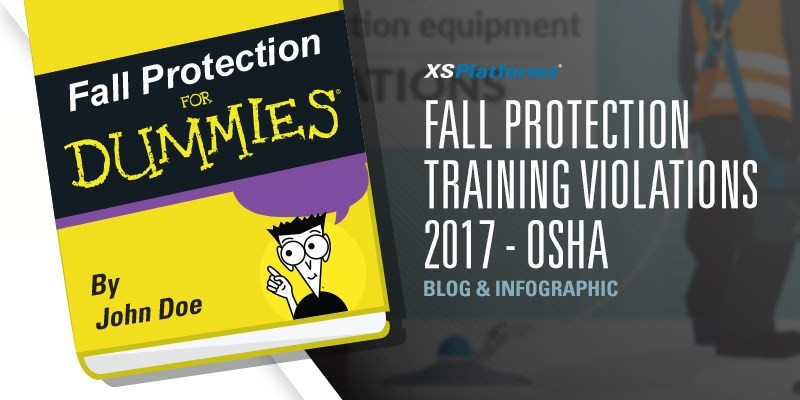
In a previous blog we looked at OSHA’s Top 10 most cited safety and health violations for the fiscal year of 2017. This top 10 rarely alters. Yet over 2017 we saw a new entry; OSHA 1926.503 Fall protection – training requirements. It is concerning to see that so many employers are cited for not giving their employees the appropriate training for the job.
Employers have a duty to keep their employees safe while working at height. Safety always starts with awareness and training. If employees do not know the hazards of their job site or do not use their provided (safety) equipment properly, their personal safety is at risk.
OSHA’s general industry rule
As of January 2017, OSHA’s final rule on General Industry Walking-Working Surfaces and Fall Protection Standards became effective. Part of this new rule is the requirement for training any and all workers who may be exposed to fall hazards (OSHA 1926.503). The training requirement isn’t unfamiliar, however its scope was broadened.
The updated regulations have most likely contributed to increased scrutiny by inspectors. Still, not providing proper fall safety training should not be taken lightly. A great number of incidents can be traced back to insufficient training, or, even a complete lack of training. Providing comprehensive training not only prevents accidents but also prevents citations.

#1 Employees must be trained
Employers must train all employees who work at height on fall hazards. Training should help workers pinpoint fall hazards in (work) areas where falls are likely to occur, and should instruct them on the proper procedures to protect them from serious injuries or even death.
OSHA also requires that all employees must understand the training. This may mean that employers have to offer training in multiple languages, or even present it in person for those who are illiterate. Always remember that the burden of proof lies with the employer. Should OSHA audit your company you will have to validate that employees understood the training, for example by means of an exam.

#2 Keep a written record
Always keep a written record! In order to prove that you’ve provided employees with proper training a written certification record must be kept. The certificate must contain:
- The name of trained employee;
- The date(s) of the training;
- The signature of the trainer;
- The signature of the employer.

#3 Can anyone train your workers?
No, not just everyone can give a required fall protection training. Although the trainer does not need a formal degree, training must be done by a competent person who:
- Knows the types of fall hazards and procedures to minimize risks.
- Knows the correct procedures for installing, maintaining, disassembling and inspecting fall protection systems.
- Knows what fall protection measures are needed in specific situations, for example guardrails, controlled access zones or the use of fall protection PPE.
- Knows the limitations of the use of mechanical equipment during roofing work on low-sloped roofs.
- Knows the proper procedures for handling and storing PPE and materials.
- Knows the role of employees in fall protection plans.
- Knows the rescue and retrieval plans.
Next to this, OSHA defines a competent person as someone “who is capable of identifying existing and predictable hazards in working conditions which are hazardous to employees. And who has authorization to take prompt corrective measures to eliminate them” (29 CFR 1926.32(f)).
#4 Retraining employees
When an employee finishes training but doesn’t display an understanding of fall hazards or the correct usage of fall protection systems, that employee must be retrained. Because he/she has not obtained the necessary skill or understanding to complete the job safely.
Other events that trigger the need for retraining include:
- Changes in the workplace that create situations not previously brought up in training.
- Changes in fall protection systems or equipment that weren’t included in previous training.
- A fall accident, or a near miss.
As falls keep being the leading cause of injury and death in the workplace, employers must ensure that training stays up-to-date. OSHA’s new rule does not specify a timeframe for retraining, but rather situations that trigger the need for new training. ANSI Z359 recommends retraining every two years if the situation hasn’t changed.

#5 Use and operation of fall protection systems
Employees must be instructed on proper and safe use of any protection necessary for the job, such as guardrails, controlled access zones or fall protection PPE. Next to this they will need to know the limitations of their equipment, how to properly treat their equipment, and how misuse can lead to serious injury or worse.
During random OSHA inspections in 2017, it was cited 35 times that the present on-site fall protection systems were not used. If you ask us, this was 35 times too much.

1 Comment. Leave new
That’s interesting that the new rule requires those who may be exposed to fall hazards to be trained since many accidents can be traced to insufficient training. It’s definitely smart to have all workers who could fall from height take the fall protection training so they can be prepared if something were to happen. This should help reduce the number of accidents since people will have to be trained before they can work at tall heights. http://canadianfallprotectioninstructor.com/courses.html